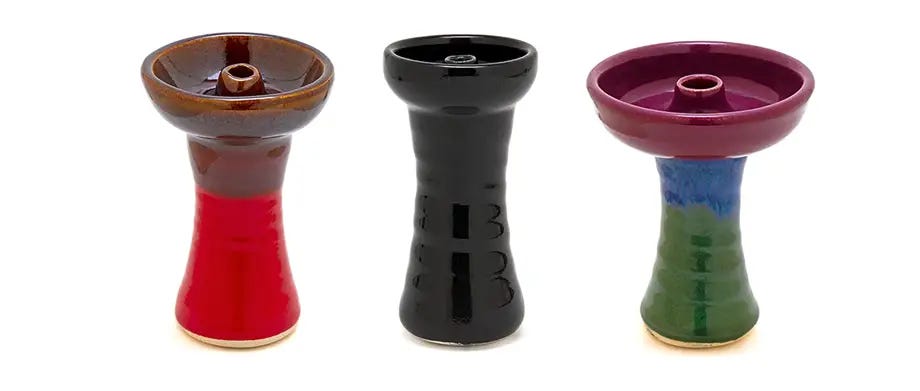
How To: Prepare & Pack Tangiers
As with any hookah practices, it's really an artform that each hookah enthusiast will develop over time; with their own personal preferences on bowl loading, heat management with the charcoal, and shisha selection. Yes, there are some tried and true methods to get you going like how much water to add to your base, how to keep your hookah clean, and knowing the differences of the many types of shisha tobacco.
While there is no "right way" to load up any type of shisha, this is a basic outline of what to expect from Tangiers shisha and the best possible start on getting a tasty bowl going.
What Is Tangiers Shisha Tobacco?
Tangiers hookah tobacco has been around for decades and is one of, if not THE most popular dark-leaf shisha brands. It was originally made in California but the company has now moved their production to Arizona.
Tangiers shisha is available in four different styles. The original Noir Tangiers is what most hookah smokers start with when they're looking to get into dark leaf shisha tobacco and has the 'normal' amount of nicotine buzz you can expect from a dark leaf tobacco. For those who want to dive into Tangiers when moving from blonde leaf shisha but want a lighter buzz then the Birquq Tangiers line is a great option.
If you're an experienced hookah smoker looking for the most buzz from your bowls, the Burley Tangiers line up is for you as it has the highest nicotine content of all of their different versions! Lastly, for anyone wanting to "go nuts" the Tangiers F-Line offers the same high nicotine content as their Burley line but the tobacco is also infused with caffeine!
No matter what style of Tangiers shisha you decide to go with, you can guarantee their rigorous quality standards are met in each bag. Every pouch receives a symbol of authenticity along with a specific distributor marking to ensure your Tangiers is legit.
Do You Need Anything Special To Enjoy Tangiers Shisha?

The "officially recommended" bowl to use when smoking Tangiers shisha are those made by them! Because Tangiers is heat sensitive and works best with a "dense pack" method, the Tangiers Bowls are perfect for this tobacco. The Tangiers bowls are a phunnel style hookah bowl which prevents the molasses from leaking down into the bowl stem and eventually down through your hookah stem. This being said you can use any other Phunnel Bowl to enjoy any of the versions of Tangiers tobacco shisha.
What about coals? Some Tangiers smokers prefer to use Japanese tab-style, silver quicklight charcoals like those from Fumari while some may prefer other types of 'regular' quicklight charcoals due to their lower heat output compared to natural hookah charcoals. With either version of these you also have the ability to break your coals in half to really dial in the perfect amount of heat.
You can still use natural charcoal of course! One tip to take note of is the style (cube or flat) and to pay more attention to the amount of heat on your bowl. Flat style natural charcoals are our favorite to use with Tangiers not only because they don't burn so hot but also due to the fact you can 'stonehenge' them (which means tipping them up on their side for the effect of "half" of a coal).
How To Use Tangiers Shisha
TL:DR = Pack your bowl tight, or with a 'dense' packing style, and pay close attention to your heat level.
Loading Your Tangiers
Of course before you pack your Tangiers shisha, give it a good stir so that the molasses can reincorporate with all of the tobacco leaves. Another hint for achieving the 'standard' Tangiers dense pack is to keep it about as tight as it was when you first opened the bag. A lot of hookah smokers like to use an Oyster Fork when loading up a bowl of Tangiers to help achieve an even pack.
As previously mentioned, every hookah smoker will tell you a different way of how they prefer to load their tobacco. From the creator to the ultimate Tangiers fans, what you'll hear most of the time is to tightly pack your Tangiers shisha in your bowl until it reaches just below the rim of the bowl or the rim of the spire - if they are at different heights. The tobacco in Tangiers performs best in this method of packing, and you will also allow enough breathing room for the shisha when you keep it below the rim of your bowl.
An easy way to do this us to fill up your bowl until it looks 'over full' and then pack it down. Make sure to remove any extra shisha until it's level and just below the rim of your bowl! Be careful not to underpack your bowl as well! Eric from Tangiers likes to use the "foil test" to check his level of shisha. This is illustrated in the video below later in the blog.
Note: You may have heard before that Tangiers shisha needs to acclimate to its smoking environment before using it. This is no longer the case although you can do so if it floats your boat. When you first open your bag of Tangiers squish it around in the bag to mix it up well, or transfer your Tangiers to a sealable container to mix it up.
Next, place your foil onto your bowl and make sure it is taught like a drum! Poke you some holes and you're ready to go! Be sure to poke holes over the hole of the spire in your phunnel bowl as well for an easy pull. Tangiers also works well with a heat management device.
Heating Your Tangiers

Due to the heat sensitive nature of Tangiers shisha it's very important to start with less heat than you would normally expect to use for other types of shisha. It's best to have some patience while the shisha heats up instead of attempting to put a lot of heat on it right away to "get it going faster". Typically most people will use two pieces of charcoal on Tangiers shisha. However, this does depend on the type of hookah charcoal you are using.
You can use any style of hookah charcoal that you prefer. Quicklighting hookah charcoal tends to give off less heat. They are also easier to break into halves or quarters if you needs "just a little" more heat.
Because natural hookah charcoals give off the maximum amount of heat, using a flat shape coal like those from CocoBrico can be an easier route for you should you choose this style of charcoal. Not only do the flat shaped natural charcoals give off slightly less heat compared to their cube shaped counterparts, you can also stand up flat pieces of charcoal on their side - what is known as "stonehenging" your charcoals to achieve a "half coal". You could also use something like Titanium Cubettes since they are a small cube.
Note: If you are using a heat management device, like a Kaloud Lotus for example, you may be able to use any style of natural hookah charcoal. Just be sure to start with less pieces and work your way up.
Best Practices For Caring For Your Tangiers Tobacco
Your Tangiers tobacco will arrive in a cellophane wrapper that is vacuum sealed, and has a large colorful factsheet wrapped around it. Don't keep it in this bag. Instead, keep it sealed in shisha storage container or something like a Tupperware dish.
Also, like with any other shisha tobacco, keep it stored in at room temperature and in a space with low humidity! For more information on storing your shisha and charcoals we've written up this blog for you.
Bonus: Watch The Founder Of Tangiers Load Up A Bowl
Who better to describe the proper loading method for Tangiers shisha than the creater himself! Watch Eric from Tangiers walk you through the packing process in the video below.
Hopefully this helps to answer some questions about the "Tangiers basics". There are as many ways to do this as there are several different flavors and flavor combination mixes to try, hopefully this is a helpful beginners guide until you can find the best method for you. Oh, and here is a list of the The Best Tangiers Flavors if you need help picking one to get started!
Have something to add? We look forward to your helpful comments :)
Until next time, happy smoking!
-Katie-
Categories
Month List
